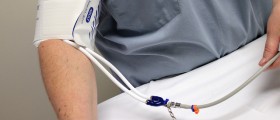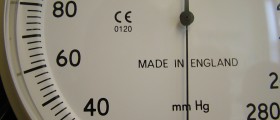
Blood pressure: The blood flowing in arteries exerts pressure onto the wall of the vessels.
To measure blood pressure, doctors use pressure cuffs and there are two pressure numbers that are recorded, systolic (first digit) pressure (which is a result of heart\'s contraction on the walls of the arteries) and diastolic (second digit) pressure (the pressure in the arteries between two contractions of the heart). Both of these are measured in mm Hg, millimeters of mercury (e.g. 120/ 80 mm Hg). The pressure is normal when within certain limits. Everything above this level is considered as high blood pressure (hypertension). Normal level is 140 mm Hg for systolic and 90 mm Hg for diastolic pressure.
Most of the patients present no symptoms even though the pressure is high. Sometimes the symptoms can be very moderate and not so specific. Being so, high blood pressure is often classified as \"the silent killer\". It happens that high blood pressure is established while regular check up after being measured.
On the other hand patients, usually ones with the extreme values of the blood pressure, show the following signs and symptoms: headache, dizziness, blurred vision, nausea and so.
What is most important to be said is that both groups of people, those who know and those who are not aware of the high blood pressure suffer equally and can develop long-term complications. Some of these are heart attack, stroke, congestive heart and kidney failure, illness of the peripheral arteries or aortic aneurysms.
The medications for this conditions are various and your doctor will prescribe the perfect combination. These drugs can control the disease and reduce the chances of getting additional diseases. This is why public awareness has aroused. Recent study has shown that there is direct relationship between the risk of dying from heart attack and high blood pressure. Furthermore high blood pressure has become the second reason for patients to see their doctors in the USA. It is estimated that around 60 million Americans suffer from high blood pressure.
The problem is that people tend to visit their doctors when organs or system of organs are already damaged by the ongoing condition. When a person has chronic high blood pressure which is not regulated by medications he or she can develop the following conditions: heart attack, stroke, kidney failure, damage of eye sight, the disease of peripheral arteries or aneurysms.
Definitely the most serious condition is malignant hypertension where diastolic blood pressure goes over 140mm Hg. The symptoms of this condition are headache, nausea etc. This condition requires urgent hospitalization and emergency reduction of the pressure since the stroke or brain hemorrhage can occur.

















Your thoughts on this
Loading...